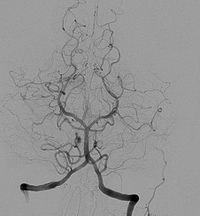
Photo from wikipedia
Background Complex angioarchitecture of brain arteriovenous malformations (BAVM) are often difficult to evaluate with standard imaging technique of digital subtraction angiography (DSA). These details are better provided by 3D rotational… Click to show full abstract
Background Complex angioarchitecture of brain arteriovenous malformations (BAVM) are often difficult to evaluate with standard imaging technique of digital subtraction angiography (DSA). These details are better provided by 3D rotational angiography (3D-RA). Objective The aim of the study is to compare two-dimensional digital subtraction angiography (2D-DSA) and 3D rotational angiography in the evaluation of BAVM angiographic architecture. Materials and Methods 2D-DSA and 3D-RA of 167 consecutive patients with BAVM were analyzed for arterial feeders, nidal patterns, and detection of flow-related aneurysms, arteriovenous fistulous components, venous drainage, and draining vein stenosis. Results 3D-RA detected a significantly higher number of aneurysms and draining venous stenoses (P < 0.001). The detected number of true intranidal aneurysms was significantly higher with 3D-RA (n = 94) vs 2D-DSA (n = 34) (P < 0.001). 2D-DSA has low sensitivity (43.1%) and specificity (73.4%) for detecting intranidal aneurysms. 3D-RA detected a significantly higher number (12.6%) of BAVM patients with feeding artery aneurysms as compared to 2D-DSA (8.4%), P value of 0.004. 3D-RA accurately depicted the distal course of dominant arterial feeders and fistulous sites in BAVMs. Direct arteriovenous communications were evident in 31.1% with 3D-RA, as compared to 2D-DSA (15%) with P value < 0.0001. A significantly higher number of draining vein stenosis was detected with 3D-RA (21.6%) as compared to 2D-DSA (13.2%), P value < 0.001. Conclusion 3D-RA is better than 2D-DSA for detecting BAVM-associated flow-related aneurysms, distal course of the dominant arterial feeders, direct visualization of the fistulous components, deep venous drainage, and draining venous stenosis; findings imperative for making a prudent therapeutic decision.
Journal Title: Neurology India
Year Published: 2022
Link to full text (if available)
Share on Social Media: Sign Up to like & get
recommendations!